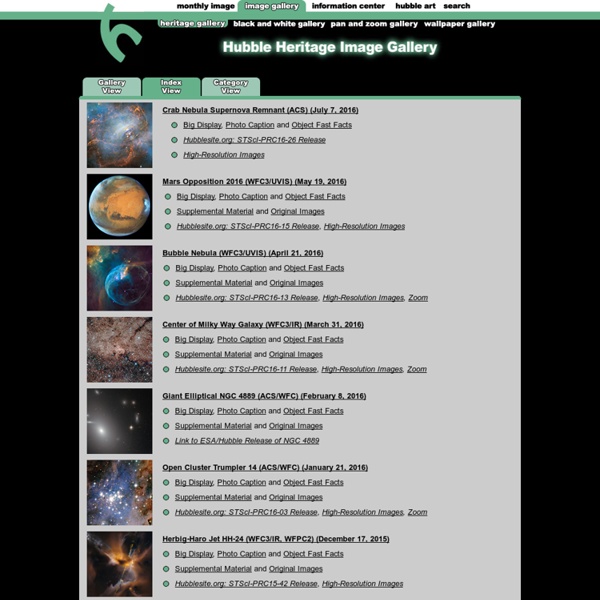



Interactive 3D model of Solar System Planets and Night Sky - StumbleUpon Pictures taken by the Hubble Space Telescope The Hubble Space Telescope was deployed from the Space shuttle Discovery during STS-31 on April 25, 1990. Since then, there have been 5 servicing missions that continued to upgrade the telescope's scientific instruments and operational systems. Hubble reached a major milestone, its 20th anniversary in orbit, on April 24, 2010. Hubble imagery has both delighted and amazed people around the world and has rewritten astronomy textbooks with its discoveries. In this dated April 24, 1990 filed photo shows the Shuttle Discovery lifts off launch pad, carrying a crew of five and the Hubble Space Telescope STS-125 crew member aboard the Space Shuttle Atlantis showing this image of the Hubble Space Telescope as the two spacecraft continued their relative separation on 19 May 2009 Hubble Space Telescope image shows in unprecedented detail the spiral arms and dust clouds of a nearby galaxy, which are the birth sites of massive and luminous stars.
Hubble Captures Violent Birth Pangs of Enormous Star | Wired Science NASA’s Hubble Space Telescope has spotted a young star undergoing violent birth. The star, named S106 IR, has a mass of about 15 times that of our sun and lies approximately 2,000 light-years away in the constellation Cygnus, the Swan. Formed from a cloud of gas and dust with more than 25,000 times the sun’s mass, the star is just about to mature and settle down to what astronomers call the main sequence portion of its life, where it will glow steadily like our sun. But before it grows up, the star is releasing a fierce torrent of ultraviolet radiation, heating up the surrounding cloud to temperatures greater than 18,000 degrees Fahrenheit. Most young stars blast tons of energy and dust, creating gigantic butterfly-wing lobes on their sides like the ones seen here. While its birth has clearly been fierce, the end of its life will be marked by an even more violent explosion: a supernova that will outshine galaxies. Image: NASA and ESA Video: NASA
Scientists Discover The Oldest, Largest Body Of Water In Existence--In Space... - StumbleUpon Scientists have found the biggest and oldest reservoir of water ever--so large and so old, it’s almost impossible to describe. The water is out in space, a place we used to think of as desolate and desert dry, but it's turning out to be pretty lush. Researchers found a lake of water so large that it could provide each person on Earth an entire planet’s worth of water--20,000 times over. Yes, so much water out there in space that it could supply each one of us all the water on Earth--Niagara Falls, the Pacific Ocean, the polar ice caps, the puddle in the bottom of the canoe you forgot to flip over--20,000 times over. The water is in a cloud around a huge black hole that is in the process of sucking in matter and spraying out energy (such an active black hole is called a quasar), and the waves of energy the black hole releases make water by literally knocking hydrogen and oxygen atoms together. The new cloud of water is enough to supply 28 galaxies with water.
Index to Physics Demonstration Equipment Index to Physics Notebooks Back to Physics Demonstrations' Home Page Acceleration A+0+0 "Coin and Feather" fall in an evacuated rotatable tube. A+0+5 Timed free fall: Ball drops 2 meters through electronic timing gate. A+0+10 Atwood machine: Unbalanced weights on a pulley accelerate slowly. A+0+15 A falling weight accelerates a car horizontally. A+0+20 Acceleration of a steel ball down an inclined plane with metronome. A+0+22 Inclined airtrack with gliders and timing gates. A+0+23 Inclined airtrack: Cart and ball accelerate in unison. A+0+25 Cork float accelerometer: Cork and water in sealed flask. A+0+30 A chain dropped onto a force plate. A+0+35 A ball swung on a string held by a sleeve. A+0+40 Conical pendulum: Similar to A+0+35 with standard weights. A+0+45 Loop the loop: Sphere, hoop, disk rolled down a looped track. A+0+47 Swing water in a bucket. A+0+50 Candles rotating about an axis. A+0+55 Mercury and colored water in a rotating glass vessel. A+0+57 Rotating loop of chain rolls across bench.
How Far Away is the Sun? Another Visualization. - Brad BlogSpeed Alright, this one’s a doozy. After the reasonable popularity of last week’s scale picture that illustrated the distance between the Earth and the Moon, I just had to take things to the next logical level. Today I’ve reduced the scale, and increased the image size dramatically, to represent one astronomical unit (AU), or the distance between the earth and the Sun. So allow me to just say ahead of time that I apologize if this post breaks anyone’s computer. I also realize that this down scrolling visual device, one that worked so well on the moon example, strains its usefulness here. But try not to, at least for a while. I had a thought while working on this today, the kind of thought that always gives me pause. If you enjoyed this post, please consider: Vidpicks is where I aggregate all the cool science/art videos I either create or scour up from across the web, and is filled with interesting, informative, and inspiring content. Cheers! *The mean distance of course. <<back to blog
Astronomical &Nightscape Photography by Chris Cook Last Update: December 12, 2015 All the images in this site are © Copyright 1987-2015 by Chris Cook. Any use of these images without the prior written consent or knowledge of the author is strictly prohibited. Current Weather on Cape Cod